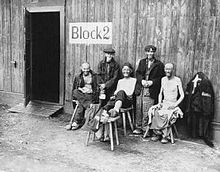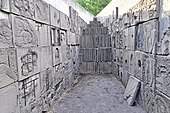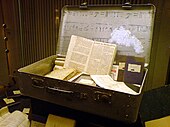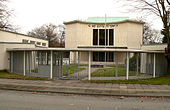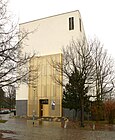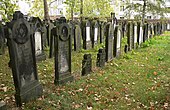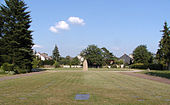Issachar Berend Lehmann, Berend Lehmann, Yissakhar Bermann Segal, Yissakhar ben Yehuda haLevi, or Berman Halberstadt, was a German banker, merchant, diplomatic agent as well as army and mint contractor working as a court Jew for Elector Augustus II the Strong of Saxony, King of Poland, and other German princes. He was privileged as a court Jew and resident. Thanks to his wealth, privileges as well as social and cultural commitment, he was a Jewish dignitary famous in his day in Central and Eastern Europe.
Landesrabbiner are spiritual heads of the Jewish communities of a country, province, or district, particularly in Germany and Austria. The office is a result of the legal condition of the Jews in medieval times when the Jewish communities formed a unit for the purposes of taxation. As the community had to pay certain taxes to the government, the latter had to appoint someone who should be responsible to it for their prompt collection, and who consequently had to be invested with a certain authority. The office of Landesrabbiner had no ecclesiastical meaning until the 18th century, when the various governments began to consider it their duty to care for the spiritual welfare of the Jews. Such ecclesiastical authority, owing to the strictly congregational constitution of the communities, never took root among the Jews.
Between the 12th century and modern times, the Swiss city of Basel has been home to three Jewish communities. The medieval community thrived at first but ended violently with the Basel massacre of 1349. As with many of the violent anti-Judaic events of the time, it was linked to the outbreak of the Black Death. At the end of the 14th century, a second community formed. But it was short-lived and disbanded before the turn of the century. For the following 400 years, there was no Jewish community in Basel. Today, there are several communities, ranging from liberal to religious to orthodox, and there are still more Jews who don’t belong to any community.
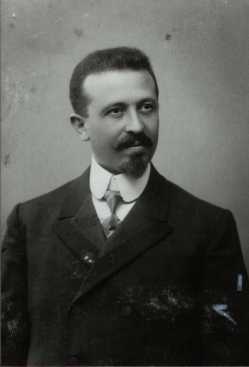
Aaron Tänzer was a rabbi in Austria and Germany, chaplain and author.
Abraham Lewinsky (1866–1941) was a late nineteenth to early twentieth century German rabbi. He was born on 1 March 1866 in Loslau, Upper Silesia, Kingdom of Prussia. He studied at the University of Breslau from 1884 to 1887, obtaining a (Ph.D.), while pursuing his rabbinical studies at the Jewish Theological Seminary in Breslau. In 1890 he became rabbi to Weilburg, and two years later assumed leadership as land rabbi of the Land Rabbinate of Hildesheim in the Province of Hanover, retiring in 1935. He died on 18 December 1941 in Mainz, People's State of Hesse.
The history of the Jews in Laupheim began in the first half of the 18th century. Until the second half of the 19th century, the Jewish community in Laupheim, expanded continuously to become the largest of its kind in Württemberg. During this period, the Jewish community gradually assimilated to its Christian surroundings and its members prospered until the beginning of the Nazi-period in 1933. With the deportation of the last remaining Jews in 1942, more than 200 years of Jewish history in Laupheim forcibly came to an end.

Meyer Kayserling was a German rabbi and historian.

Adelebsen is a municipality in the district of Göttingen, in Lower Saxony, Germany. It consists of the localities Adelebsen, Barterode, Eberhausen, Erbsen, Güntersen, Lödingsen and Wibbecke. The Burg Adelebsen is located on a high point in Adelebsen proper.

Rykestrasse Synagogue, Germany's largest synagogue, is located in the Prenzlauer Berg neighbourhood in the Pankow borough of Berlin. Johann Hoeniger built the synagogue in 1903/1904. It was inaugurated on 4 September 1904, in time for the holidays of and around Rosh Hashanah. The synagogue stands off the street alignment and is reached by a thoroughfare in the pertaining front building.

The Hamburg Temple was the first permanent Reform synagogue and the first ever to have a Reform prayer rite. It operated in Hamburg (Germany) from 1818 to 1938. On 18 October 1818 the Temple was inaugurated and later twice moved to new edifices, in 1844 and 1931, respectively.

The history of the Jews in Cologne dates to 321 C.E., when it was recorded in a census decreed by the Emperor Constantine I. As such, it is the oldest European Jewish community north of the Alps. The community quickly established itself in what came to be known as Cologne's Jewish quarter, building its first synagogue by 1040 C.E. The Crusades put an end to peaceful coexistence with Christians in 1096 C.E. Despite the Archbishop's protection many Jews were killed and their synagogue destroyed. The community regained its economic and religious life until about 1300 C.E., when the Christian majority again applied pressure. The community's fortunes improved and worsened a number of times into the 20th century. Before the 1930s, it consisted of 19,500 people. After the end of World War II it had been almost entirely extinguished due to Nazi destruction, expulsion and murder. Currently it numbers approximately 5,000.

The history of the Jews in Hamburg in Germany is recorded from at least 1590 on. Since the 1880s, Jews of Hamburg have lived primarily in the neighbourhoods of Grindel, earlier in the New Town, where the Sephardic Community "Neveh Shalom" was established in 1652. Since 1612 there have been toleration agreements with the senate of the prevailingly Lutheran city-state. Also Reformed Dutch merchants and Anglican Britons made similar agreements before. In these agreements the Jews were not permitted to live in the Inner-City, though were also not required to live in ghettos.
Leopold Jakob Jehuda Treitel was a German Jewish classical scholar in the late 19th and early 20th century, and the last rabbi of the Jewish community in the town of Laupheim, then Württemberg, Southern Germany.
Israel Alter was an Austrian-Hungarian Jewish cantor and last chief cantor in Hanover, Germany. The well traveled composer was regarded as "the one Chasanim, the cantor of the cantors".

Hermann Simon is a German historian who was for 27 years director of the Foundation "New Synagogue Berlin - Centrum Judaicum".

The old Rottweil Synagogue is a synagogue in Rottweil in Baden-Württemberg. It was established in 1861. The desecrated Synagogue is located in Kameralamtsgasse 6, former Judengasse, close to Kapellenkirche and next to Bischöfliches Konvikt and gymnasium. The construction of a new synagogue in Rottweil began in March 2016.
Siegbert Einstein was a German-Jewish politician, factory worker, civil servant, lawyer, Holocaust survivor, and the last Jew who lived in the Jewish community in Bad Buchau.

Tobias Jakobovits was a Rabbi, historian and Czech librarian, historian of Czech Jewry, and an expert in ancient Hebrew manuscripts. He was the chief librarian of the Prague Jewish community in the inter-war period, and the professional manager of the Jewish Museum in Prague during the Nazi Occupation. He was deported to the Auschwitz concentration camp in the fall of 1944 and was murdered there along with his wife.
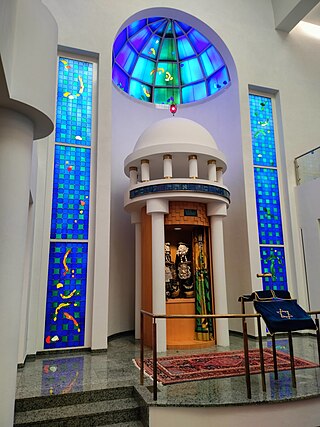
The Neue Synagoge is the synagogue, community centre, and museum of the Jewish community in Darmstadt. Inaugurated on in 1988, the synagogue was built as part of a citizens’ initiative to commemorate the 50th anniversary of Kristallnacht Known also as the ‘Holocaust Memorial Synagogue’, the architectural complex was designed to fulfil the needs of the city's Jewish population, who had been without a place of worship since the 1938 pogrom when Darmstadt's three synagogues were destroyed. Built according to plans by Alfred Jacoby, with a significant programme of stained glass windows designed by British architectural artist Brian Clarke. The religious and cultural complex is located on the site of the city's former Gestapo headquarters.
Bankhaus Adolph Meyer was a private bank, and the oldest in Hanover, Germany. It played a prominent role in the industrialization of Lower Saxony, particularly in the cotton and coal and steel industries, especially since the time of the Kingdom of Hanover. During the Nazi era, it was "Aryanized". It is now located on Schillerstraße at the corner of Rosenstraße in Hannover's Mitte district.


